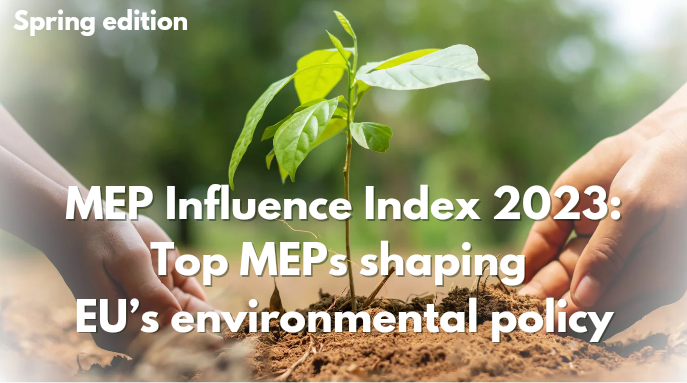Are you sure you want to perform this action?
Updates

MEP Influence Index 2023: Top MEPs shaping EU’s environmental policy
This analysis measures the influence that Members of the European Parliament are exerting over EU legislation and documents that shape environmental policy. It is part of a series of reports that includes:
MEP Influence Index overall (across all policy areas)
MEP Influence Index in Trade policy
MEP Influence Index in Agri-food policy
MEP Influence Index in Digital policy
MEP Influence Index in Social policy
MEP Influence Index in Health policy
This research measures MEPs’ influence through a combination of criteria clustered in the following categories: formal and informal leadership positions, actual legislative work, political network, committee membership and voting behaviour. To read the full methodology, click here.
NB: we will soon publish an assessment of the Commissioners’ performance and their chances of being re-elected. If you wish to contribute to this assessment, feel free to take our quick survey.
Key findings
-The top 5 most influential MEPs shaping environmental policy are: Mohammed Chahim, Pascal Canfin, Jutta Paulus, María Soraya Rodríguez Ramos and Martin Hojsík.
-Influence tends to be concentrated among MEPs from North-Western Europe, especially Finns and Dutch. Conversely, MEPs from CEE and Southern delegations tend to punch below their weight on environmental topics
-While we see a general balance of power between different groups on this topic, Renew MEPs tend to overperform their colleagues on environmental issues, which is due to the central position of the group in an increasingly polarised Parliament. 5 Renew MEPs made it to the top 10 most influential MEPs on environmental topics.
More details on the above findings can be found below.
Important: when tracking influence over EU policies, always bear in mind that while individual MEPs are the visible signatories of initiatives or amendments, they are not operating in an information vacuum. Rather, their views and actions are shaped by bigger political and societal forces / pressures that surround them and that they are networking with.
To understand the full picture, you need to look at the strength of these forces and the direction in which they are pushing and pulling. For example, the chart below shows the level of influence of all MEPs on regulation on the environmental sector, but also the direction in which each of them is working to influence this policy area, e.g. whether they promote a stronger focus on the environment or prioritise economic concerns. Particular attention should be paid to the MEPs who are in the middle, i.e. they have both a fair level of influence and moderate views, because in the current fragmented political landscape, these MEPs (swing voters) are the ones that make the difference, i.e. their votes are the ones that decide whether a key paragraph is approved or not.
Note: in the chart below, only the names of top MEPs are revealed. To uncover the full picture, contact us at [email protected].
NB: We expect a significant turnover in the composition of the European Parliament after the 2024 elections. According to our latest calculations, only 42% of the current cohort of MEPs will be re-elected next year, although the chances of the top MEPs to make it are higher (but only slightly). Contact us at [email protected] to get timely predictions and updates on the future composition of the European parliament, including the likely new MEPs and their backgrounds.
Trends by national groups
When looking at the trends by national groups, we can see a stronger concentration of influence among North-Western delegations, especially Dutch and Finnish MEPs. These national groups are also over-represented in the key ENVI committee, thus giving them an edge when it comes to shaping the European Green Deal. Notably, 3 Dutch from different parties are featured in our top 10 of most influential MEPs on environmental matters (Chahim, Huitema and Eickhout).
On the opposite side, delegations from CEE and Southern Europe tend to underperform on this topic. This is due to their weak representation in ENVI (and other relevant committees), but also their difficulties in pushing back against the green agenda in an institution that is currently dominated by centre-left majorities on environmental topics.
Trends by political groups
The top ranking is dominated by centre-to-the-left MEPs, who tend to over-perform their colleagues from other groups on this topic. In particular, the MEPs from the Renew Europe group tend to punch above their weight the most when it comes to environmental issues, as seen by the strong representation of the group at the top of our influence list (in addition to the above mentioned Canfin, Rodríguez and Hojsík, Torvalds and Huitema also make it to the top 10 most influential MEPs on environmental issues).
Would you like to find out who are the MEPs with moderate views that are most likely to make or break majorities in the current European Parliament or after the next elections? Feel free to contact us at [email protected] for more information on our data-driven services.
